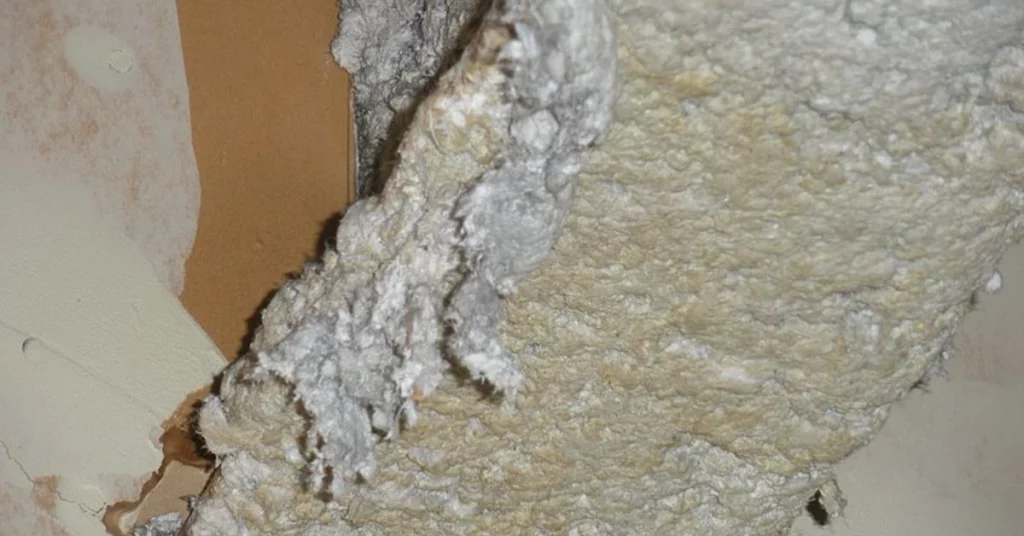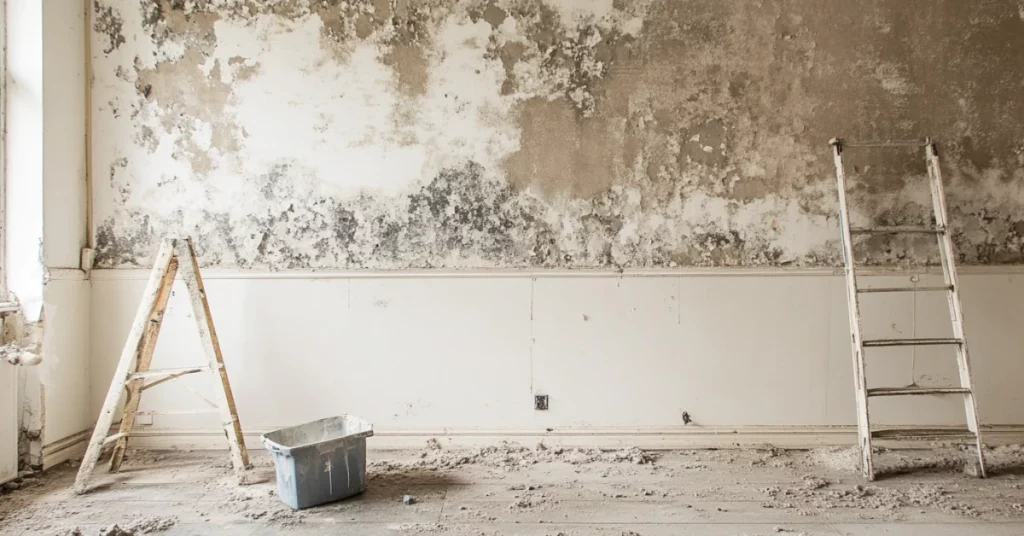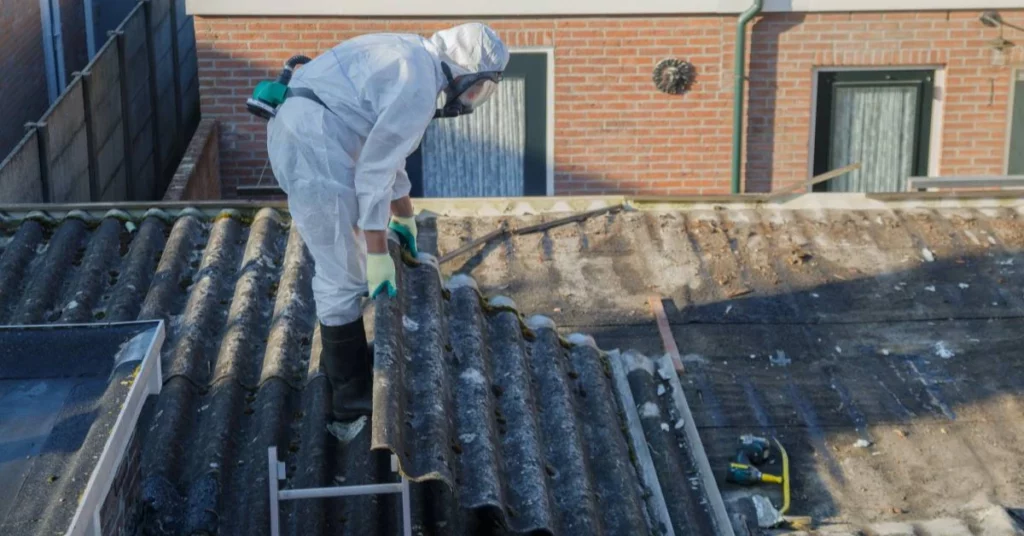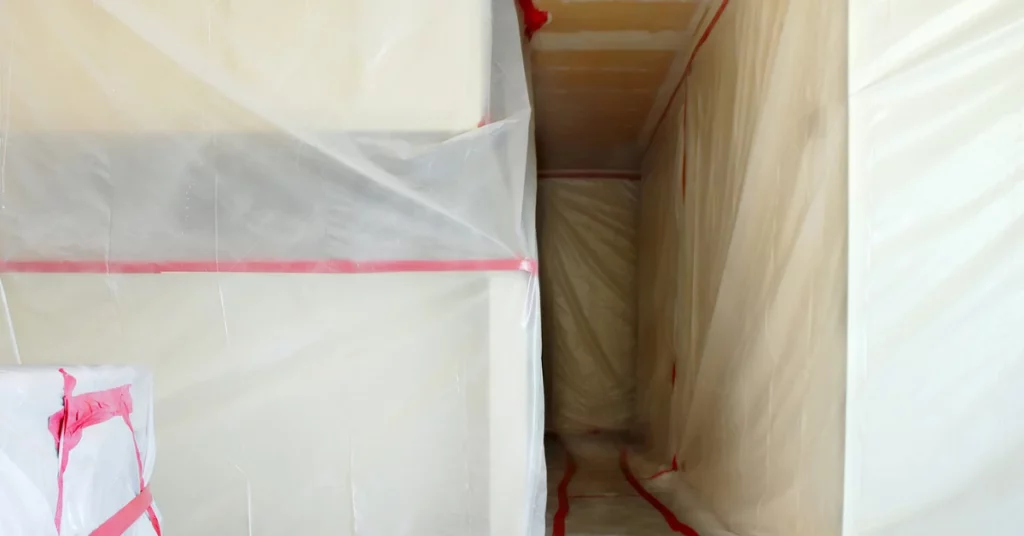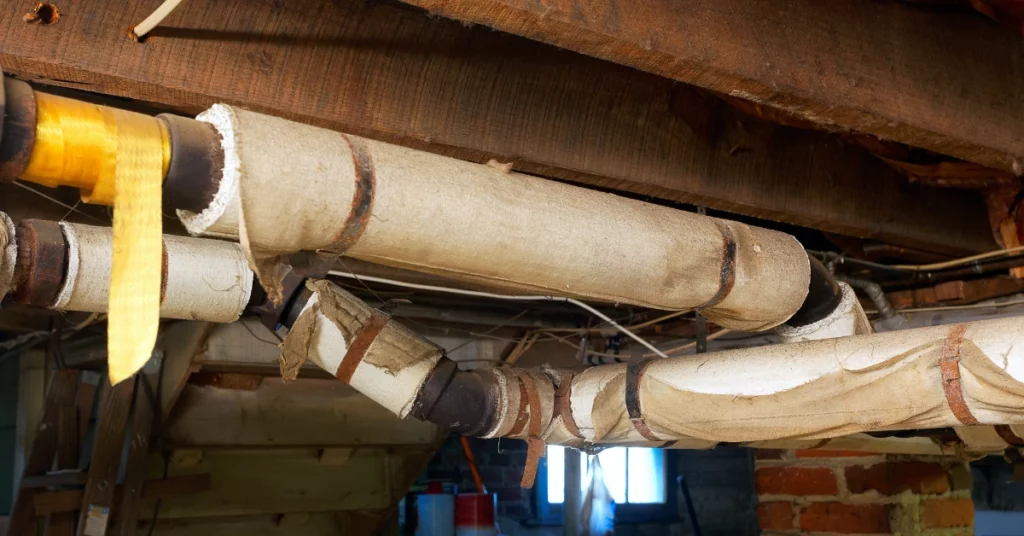How Much Does Asbestos Removal Cost?
The typical range for asbestos removal projects falls between $1,192 and $3,254. However, the actual cost can vary significantly based on several factors, which we’ll explore in detail.
Asbestos, a group of naturally occurring fibrous minerals, was once widely used in construction due to its heat-resistant properties and durability. However, we now know that asbestos fibers can cause serious health issues when inhaled, including lung cancer and mesothelioma.
Many older homes and buildings contain asbestos in various materials, such as insulation, flooring, and roofing. When these materials deteriorate or are disturbed during renovations, they can release harmful fibers into the air. This is why proper asbestos removal is often necessary to ensure a safe living or working environment.
We will cover the costs associated with asbestos removal, the factors that influence pricing, and what to expect during the removal process. We’ll also discuss alternatives like encapsulation and provide guidance on when to seek professional help.
Remember, while cost is an important consideration, the safety of you and your family should be the top priority when dealing with asbestos. Always consult with certified professionals before making decisions about asbestos management in your home or building.
Factors Affecting Asbestos Removal Cost
The cost of asbestos removal can vary widely depending on several key factors.
Size of Affected Area
The extent of asbestos contamination significantly impacts the overall cost. Larger areas require more time, labor, and materials to treat properly. For example, removing asbestos from a small closet will cost less than addressing an entire attic or basement. Contractors often price their services by square footage, so accurately measuring the affected area is crucial for obtaining precise estimates.
Types of Asbestos
Different types of asbestos materials can affect removal costs:
- Friable asbestos (easily crumbled) is typically more expensive to remove due to increased safety precautions.
- Non-friable asbestos (tightly bound in other materials) may be less costly to handle but still requires careful treatment.
Common types include chrysotile (white asbestos), amosite (brown asbestos), and crocidolite (blue asbestos). The specific type present in your property may influence the removal method and associated costs.
Labor
Asbestos removal is a specialized task requiring trained professionals. Labor costs can vary based on:
- The complexity of the job
- Local market rates
- The number of workers needed
- Time required to complete the project
Some regions may have higher labor costs due to increased demand or stricter regulations.
Materials and Equipment
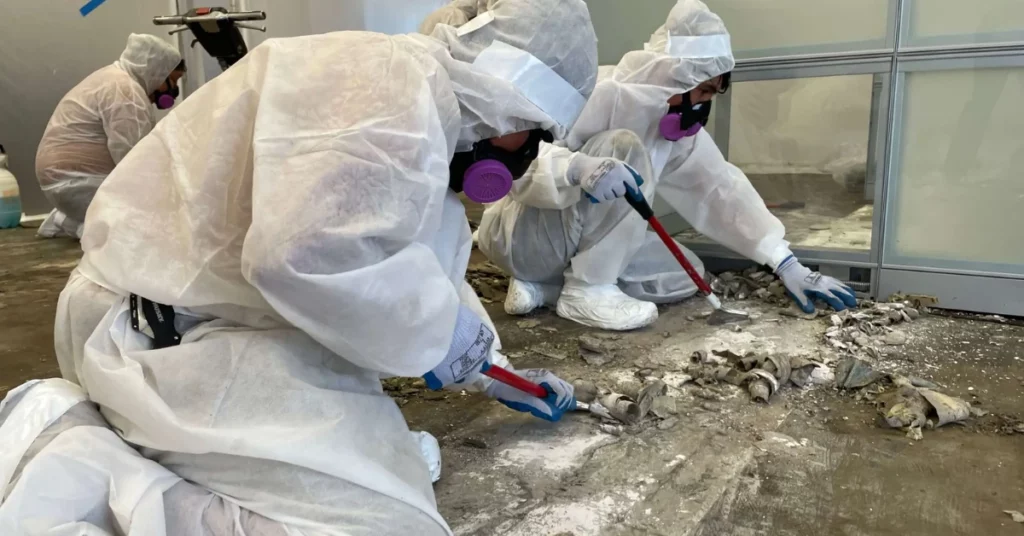
Proper asbestos removal requires specific safety equipment and tools, including:
- Protective suits and respirators
- HEPA filters and vacuums
- Containment materials (plastic sheeting, tape)
- Specialized cleaning supplies
The cost of these materials is factored into the overall project price.
Asbestos Disposal
Asbestos waste must be disposed of according to strict regulations. This often involves special containment bags or wrapping, transportation to approved disposal sites, and disposal fees at specialized facilities.
These disposal costs are typically included in the total project price but can vary based on local regulations and disposal site fees.
Post-Removal Repairs
After asbestos removal, the affected area may need repairs or restoration. This could involve replacing insulation, repairing or replacing drywall, and refinishing floors or ceilings.
The extent of necessary repairs can significantly impact the overall project cost.
Asbestos Encapsulation
In some cases, encapsulation (sealing asbestos-containing materials) may be a viable alternative to removal. This process typically costs less than full removal but may not be suitable for all situations. The decision between removal and encapsulation depends on the condition of the asbestos-containing materials and local regulations.
How Long Does Asbestos Removal Take?
Asbestos removal time can vary depending on several factors:
- Size of the affected area: Larger areas naturally take longer to treat.
- Location of the asbestos: Some areas, like attics or crawl spaces, may be more time-consuming to access and work in.
- Type of asbestos-containing material: Different materials require different removal techniques, which can affect the timeline.
- Extent of contamination: Widespread or severe contamination may take longer to address.
Complexity of the removal: Some projects may require additional steps, such as rebuilding or restoration after removal.
General time estimates:
- Small, localized removal (e.g., a single room or small area): 1-3 days
- Medium-sized project (e.g., multiple rooms or an attic): 3-5 days
- Large-scale removal (e.g., entire house or commercial building): 1-2 weeks or more
It’s important to note that these are rough estimates. The actual time can vary based on the specific circumstances of each project. Additionally, the process typically involves several stages:
- Initial inspection and testing: 1-2 days
- Planning and preparation: 1-3 days
- Setup of containment area: 1 day
- Actual removal: Varies based on project size
- Cleanup and disposal: 1-2 days
- Final inspection and air testing: 1-2 days
Professionals may need to wait for air test results before declaring the area safe, which can add time to the overall process.
Remember, rushing asbestos removal can lead to unsafe practices. It’s crucial to allow adequate time for proper removal and testing to ensure the safety of both the workers and future occupants of the building.
Cost of Asbestos Removal by Location in a Home

Asbestos can be found in various locations throughout a home, and the cost of removal can differ depending on where it’s located. Here’s a breakdown of common areas and their associated removal costs:
HVAC Ducts
Asbestos was sometimes used in HVAC duct insulation and tape. Removal may involve replacing entire duct systems.
Estimated cost range: $15 – $30 per linear foot
Basements
Basements can contain multiple asbestos sources, including insulation, flooring, and pipe coverings. The variety of potential asbestos-containing materials can make basement remediation complex.
Estimated cost range: $5 – $20 per square foot, depending on the extent and types of asbestos present
Remember, these are estimated ranges, and actual costs can vary based on factors like the size of the area, the condition of the asbestos-containing materials, and local market rates.
Walls and Drywall
Asbestos was often used in joint compounds and some older drywall. Removal typically involves careful demolition and replacement of affected areas. The process can be labor-intensive, especially if the asbestos-containing materials are widespread.
Estimated cost range: $1,000 – $3,000 per room
Roof and Shingles
Some older roofing materials, including shingles and underlayment, may contain asbestos. Removal often involves replacing the entire roof.
Estimated cost range: $50 – $120 per square foot
Siding
Asbestos-cement siding was popular for its durability. Removal must be done carefully to avoid breaking the siding and releasing fibers.
Estimated cost range: $8 – $15 per square foot
Flooring and Floor Tile
Vinyl floor tiles and sheet flooring from certain eras often contain asbestos. Removal can be complicated if the adhesive also contains asbestos.
Estimated cost range: $5 – $15 per square foot
Popcorn Ceilings
Many homes built before the 1980s have textured “popcorn” ceilings that may contain asbestos. Removal involves scraping off the textured material, containing the debris, and refinishing the ceiling.
Estimated cost range: $3 – $7 per square foot
Attic Insulation
Loose-fill asbestos insulation was commonly used in attics. Removal requires careful vacuuming and containment procedures.
Estimated cost range: $3 – $10 per square foot
Pipe Insulation
Asbestos was commonly used to insulate pipes, especially in older homes. Removal can be tricky, especially in hard-to-reach areas.
Estimated cost range: $10 – $15 per linear foot
Wire Insulation
Some older electrical systems used asbestos insulation around wiring. Removal often requires the expertise of both asbestos professionals and electricians.
Estimated cost range: $8 – $15 per linear foot
How Much Does Asbestos Encapsulation Cost?

Asbestos encapsulation is an alternative to removal in certain situations. This process involves sealing asbestos-containing materials to prevent fiber release.
What is Encapsulation?
Encapsulation uses a sealant to coat asbestos-containing materials, creating a barrier that prevents fibers from becoming airborne. This method can be effective when asbestos materials are in good condition and not likely to be disturbed.
Typical Cost Range for Encapsulation
Encapsulation generally costs less than full removal. Prices typically range from $2 to $6 per square foot. However, costs can vary based on the area size, material type, and accessibility.
Factors affecting encapsulation costs include:
- Area size: Larger areas will require more sealant and labor.
- Material type: Different asbestos-containing materials may require specific sealants.
- Accessibility: Hard-to-reach areas may increase labor costs.
- Sealant quality: Higher-quality, longer-lasting sealants may cost more initially.
Pros of Encapsulation:
- Lower cost compared to removal
- Less disruptive to building occupants
- Quicker process than full removal
- Can be effective for materials in good condition
Cons of Encapsulation:
- Not a permanent solution – requires ongoing monitoring
- May not be suitable for damaged or deteriorating materials
- Can complicate future renovations or demolitions
- May not comply with regulations in all situations
Encapsulation might be appropriate when:
- Asbestos-containing materials are in good condition
- The area is unlikely to be disturbed in the future
- Full removal is not feasible due to cost or structural concerns
- Local regulations permit encapsulation as a management method
When deciding between encapsulation and removal, consider:
- The condition of the asbestos-containing materials
- Long-term plans for the building
- Local regulations and guidelines
- Budget constraints
- Recommendations from certified asbestos professionals
It’s important to note that while encapsulation can be a cost-effective solution in some cases, it’s not always the best choice.
Regardless of whether you choose encapsulation or removal, the work should be performed by trained and certified professionals to ensure safety and compliance with regulations.
How to Know When to Remove Asbestos

Knowing when asbestos removal is necessary is crucial for maintaining a safe environment. Key situations that typically call for asbestos removal are:
Damaged or Deteriorating Materials
If asbestos-containing materials are fraying, crumbling, or otherwise deteriorating, removal is often the safest option. Damaged materials are more likely to release harmful fibers into the air.
During Renovations or Demolitions
Any renovation or demolition work that might disturb asbestos-containing materials requires proper management. In many cases, removal is the best course of action before proceeding with construction work.
Before Selling a Property
While not always legally required, removing known asbestos can increase property value and ease the selling process. Some buyers may insist on asbestos removal as a condition of purchase.
Health Concerns
If occupants have health issues that might be exacerbated by the presence of asbestos, removal may be advisable even if the materials appear intact.
Regulatory Requirements
Local or state regulations may mandate removal in certain situations, such as in public buildings or before major renovations.
When Encapsulation Isn’t Viable
If the asbestos-containing materials are in poor condition or in an area where encapsulation wouldn’t be effective long-term, removal is often necessary.
Future Planning
If you anticipate future renovations or changes that would disturb the asbestos-containing materials, it might be more cost-effective to remove the asbestos now rather than later.
Water Damage
Areas with water damage may require asbestos removal, as moisture can cause asbestos-containing materials to break down more quickly.
If asbestos-containing materials are in good condition and not likely to be disturbed, immediate removal might not be necessary. Regular monitoring may be sufficient.In some cases, encapsulation might be a suitable alternative to removal, especially for materials in good condition.
Consultation with Professionals
Deciding whether to remove asbestos should always involve consultation with certified asbestos professionals. They can:
- Assess the condition of asbestos-containing materials
- Evaluate the risk of fiber release
- Recommend the most appropriate action (removal, encapsulation, or management in place)
- Ensure compliance with local regulations
Remember, improper handling of asbestos can create greater health risks than leaving intact materials undisturbed.
DIY Asbestos Removal vs. Professional Asbestos Abatement
When it comes to asbestos removal, the choice between DIY and professional services is clear: always opt for certified professionals. Here’s why:
Risks of DIY Asbestos Removal:
- Health Hazards: Improper handling can release asbestos fibers, posing serious health risks to you and others in the building.
- Inadequate Equipment: Proper asbestos removal requires specialized equipment that most homeowners don’t have access to.
- Contamination Spread: Without proper containment procedures, you risk spreading asbestos fibers to other areas of your home.
- Legal Issues: In many areas, DIY asbestos removal is illegal. You may face fines or legal consequences.
- Disposal Challenges: Asbestos waste requires special handling and disposal methods that aren’t typically available to the public.
Benefits of Hiring Certified Professionals:
- Expertise: Certified professionals have the training and experience to handle asbestos safely.
- Proper Equipment: They use specialized tools and protective gear to minimize risks.
- Containment: Professionals set up proper containment areas to prevent the spread of asbestos fibers.
- Testing: They can perform air quality tests before and after removal to ensure safety.
- Legal Compliance: Professional removal ensures adherence to local, state, and federal regulations.
- Proper Disposal: Certified contractors have access to approved asbestos disposal facilities.
- Insurance: Reputable companies carry insurance to protect you in case of accidents or unforeseen issues.
- Peace of Mind: Professional removal provides assurance that the job is done safely and thoroughly.
Choosing a Professional Asbestos Removal Company
When selecting a contractor for asbestos removal, there are several key factors to consider. Start by verifying that the company has proper licensing and certifications for asbestos removal. It’s also wise to check references by contacting previous clients to gauge their satisfaction with the work performed.
To ensure you’re getting a fair price, obtain and compare quotes from multiple companies. During this process, ask each company about their removal and safety procedures; a reputable firm will be happy to explain their methods in detail. Don’t forget to confirm that the contractor has adequate insurance coverage to protect you in case of any issues.
Before any work begins, always insist on a detailed, written contract. While professional asbestos removal might appear costly at first glance, it’s important to remember that the potential costs of DIY removal – including health risks, property damage, and legal problems – far exceed any initial savings.
Safety should always be the primary concern when dealing with asbestos. If you suspect the presence of asbestos in your property, resist the urge to sample or remove it yourself. Instead, reach out to a certified asbestos professional who can inspect the area and provide expert guidance on how to proceed safely.
Asbestos Removal in Residential vs. Commercial Buildings
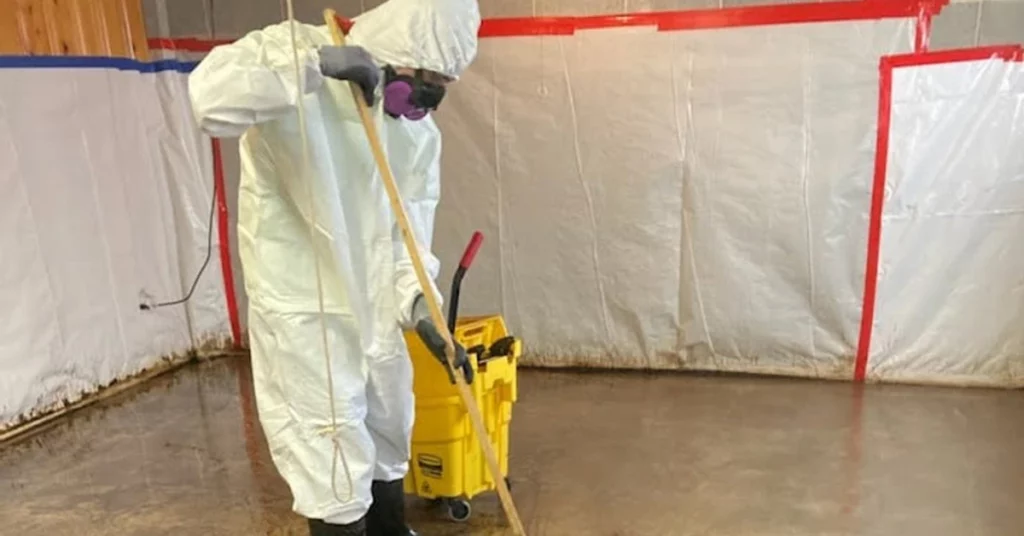
While the basic principles of asbestos removal apply to both residential and commercial properties, there are some key differences in approach, scale, and regulations.
Residential Asbestos Removal
Residential asbestos removal typically involves smaller-scale projects in homes or apartment buildings. These projects often focus on specific areas like attics, basements, or individual rooms. The process usually affects fewer people, primarily the homeowners and their families.
Key aspects of residential asbestos removal include:
- Shorter project durations due to smaller areas
- Less complex containment setups
- Often scheduled around the occupants’ daily routines
- May require temporary relocation of residents during the removal process
- Costs are typically borne by individual homeowners or landlords
Commercial Asbestos Removal
Commercial asbestos removal projects tend to be larger in scale, often encompassing entire office buildings, schools, hospitals, or industrial facilities. These projects can be more complex due to the size of the buildings and the number of people potentially affected.
Commercial asbestos removal often involves:
- Longer project durations due to larger affected areas
- More extensive containment and decontamination setups
- Careful scheduling to minimize disruption to business operations
- Potential for phased removal to allow partial occupancy of the building
- Costs may be covered by business owners, property management companies, or government entities for public buildings
Regulatory Differences
While safety is paramount in both residential and commercial removals, commercial projects often face stricter regulations:
- Notification requirements: Commercial projects typically require formal notification to relevant authorities before work begins.
- Air monitoring: More rigorous air quality testing is often mandated for commercial removals, both during and after the process.
- Documentation: Commercial projects usually require more extensive record-keeping and reporting to regulatory agencies.
- Worker safety: While important in all removals, commercial projects may have additional requirements for worker protection and training.
Challenges Unique to Commercial Removals:
- Coordinating with multiple stakeholders (business owners, employees, customers)
- Managing removal in high-traffic areas
- Dealing with more complex building systems (HVAC, electrical, plumbing)
- Ensuring business continuity during the removal process
- Addressing public relations concerns, especially for schools or public buildings
Despite these differences, the fundamental goal remains the same for both residential and commercial asbestos removal: to safely and effectively eliminate the health risks associated with asbestos-containing materials.
Frequently Asked Questions
Are asbestos removal contractors required to have certifications?
Yes, asbestos removal contractors are required to have specific certifications. The exact requirements can vary by location, but generally include:
- Federal certification from the Environmental Protection Agency (EPA)
- State-level licensing or certification
- OSHA (Occupational Safety and Health Administration) training for workers
Always verify a contractor’s credentials before hiring them for asbestos removal.
How do I know if there is asbestos in my home?
You can’t identify asbestos just by looking at a material. If you suspect asbestos:
- Consider the age of your home (homes built before 1980 are more likely to contain asbestos)
- Look for common asbestos-containing materials like popcorn ceilings, vinyl floor tiles, or pipe insulation
- Do not disturb the suspected material
- Hire a certified asbestos inspector to take samples and have them analyzed by an accredited laboratory
Does a home seller have to disclose asbestos to potential home buyers?
Disclosure requirements vary by state, but in general, many states require sellers to disclose known asbestos in the property. Some states require disclosure only if the asbestos poses a health hazard. Even in states without specific asbestos disclosure laws, general disclosure laws often cover such health and safety issues
It’s best to consult with a local real estate attorney for specific requirements in your area.
Does asbestos affect home value?
The presence of asbestos can impact home value:
- Homes with known asbestos may sell for less due to the potential removal costs
- Properly encapsulated or removed asbestos may have minimal impact on value
- Some buyers may be deterred by the presence of asbestos, even if it’s not currently hazardous
Professional removal or proper management of asbestos can help maintain property value.
Can you get free asbestos removal?
Free asbestos removal is rare, but there are some potential options:
- Some local governments offer assistance programs for low-income homeowners
- Certain non-profit organizations may provide help in specific cases
- In rare instances, property owners may qualify for assistance if the asbestos is linked to a public health emergency

